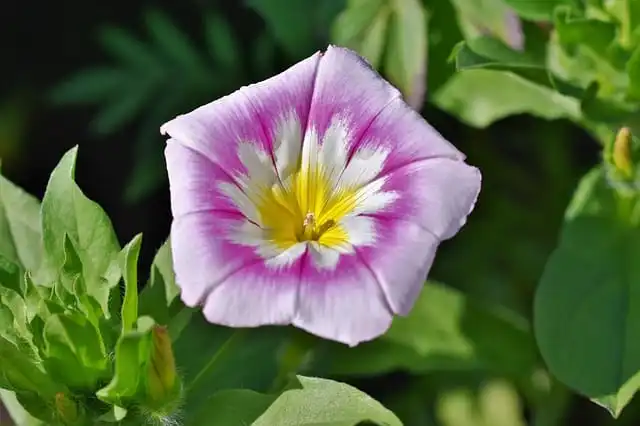Introduction
Morning Glory flowers, renowned for their vibrant colors and rapid growth, are a delightful addition to any garden. This expert guide provides comprehensive insights into cultivating healthy and flourishing Morning Glory vines, drawing upon reputable government and horticultural bodies, as well as academic experts.
Selecting Morning Glory Varieties
Begin by choosing Morning Glory varieties that suit your garden’s aesthetic and your local climate. Reference resources from the United States Department of Agriculture (USDA) for insights into plant hardiness zones and recommendations for specific Morning Glory cultivars.
Soil Preparation and pH Adjustment
Morning Glory thrives in well-drained, fertile soil with a slightly acidic to neutral pH. Conduct a soil test and amend the soil with organic matter, following guidelines from your local Agricultural Extension Service for optimal growing conditions.
Planting Morning Glory Seeds
Directly sow Morning Glory seeds in the garden after the last frost, following recommended planting depths and spacing. Ensure the planting site receives full sunlight, as Morning Glory vines flourish in sunny conditions.
Providing Support Structures
Morning Glory vines are climbers that benefit from support structures such as trellises or fences. Explore recommendations from horticultural organizations for proper staking techniques to facilitate healthy growth.
Watering Practices
Maintain a consistent watering schedule, keeping the soil evenly moist during the growing season. Avoid overwatering, as Morning Glory plants are susceptible to root rot. Utilize mulch to retain soil moisture.
Sunlight Requirements
Morning Glory flowers thrive in full sunlight. Ensure that the planting site receives at least 6-8 hours of direct sunlight daily for robust and prolific blooming.
Fertilization Techniques
Morning Glory plants generally do well in average soils and don’t require heavy fertilization. Follow soil test recommendations and use a balanced, all-purpose fertilizer sparingly during the growing season.
Pruning and Deadheading
Promote bushier growth by occasionally pruning Morning Glory vines. Deadhead spent flowers regularly to encourage continuous blooming. Refer to guidelines from horticultural experts for specific pruning techniques.
Pest and Disease Management
Monitor for pests such as aphids and spider mites. Implement Integrated Pest Management (IPM) strategies recommended by organizations like the National Integrated Pest Management Network (NIPMN) for effective and environmentally friendly control.
Overwintering Morning Glory
Morning Glory is an annual, but you can collect seeds for the next growing season. Harvest mature seeds, allow them to dry, and store them in a cool, dry place for successful propagation.
Conclusion
By integrating guidance from government bodies, horticultural organizations, and academic experts, you can successfully cultivate vibrant and rapidly growing Morning Glory flowers in your garden. Follow these expert guidelines for a rewarding Morning Glory-growing experience.
Why should I consider growing Morning Glory flowers in my garden?
Morning Glory flowers are renowned for their vibrant colors, rapid growth, and charming blooms, making them an attractive addition to any garden or trellis.
When is the best time to plant Morning Glory seeds?
Directly sow Morning Glory seeds in the garden after the last frost, ensuring soil temperatures are suitable for germination.
Do Morning Glory flowers require full sunlight, and what if I have limited sunlight in my garden?
Morning Glory flowers thrive in full sunlight but can tolerate partial shade. Ensure they receive at least 6-8 hours of direct sunlight daily for optimal growth.
What type of soil do Morning Glory flowers prefer, and how should I prepare it?
Morning Glory flowers thrive in well-drained, fertile soil with a slightly acidic to neutral pH. Amend the soil with organic matter following recommendations from local agricultural extension services.
How do I support Morning Glory vines, and do they need trellises?
Morning Glory vines are climbers and benefit from support structures such as trellises or fences. Explore recommendations from horticultural organizations for proper staking techniques.
What is the best watering routine for Morning Glory flowers?
Maintain a consistent watering schedule, keeping the soil evenly moist during the growing season. Avoid overwatering to prevent root rot.
Do Morning Glory flowers need fertilization, and how often should I fertilize them?
Morning Glory plants generally do well in average soils and don’t require heavy fertilization. Follow soil test recommendations and use a balanced, all-purpose fertilizer sparingly during the growing season.
Is pruning necessary for Morning Glory vines, and how should I do it?
Occasional pruning promotes bushier growth in Morning Glory vines. Deadhead spent flowers regularly to encourage continuous blooming. Refer to guidelines from horticultural experts for specific pruning techniques.
What pests and diseases should I watch out for when growing Morning Glory flowers?
Monitor for common pests such as aphids and spider mites. Implement Integrated Pest Management (IPM) strategies outlined by organizations such as the National Integrated Pest Management Network (NIPMN) for effective control.
Can I collect Morning Glory seeds for the next growing season, and how should I store them?
Yes, harvest mature Morning Glory seeds, allow them to dry, and store them in a cool, dry place for successful propagation in the following year.
- Explore THC Infused Drinks in New York - May 9, 2025
- The Latest in THC Seltzers Across Texas - May 9, 2025
- Top THC Infused Drinks Available in Oklahoma - May 9, 2025




